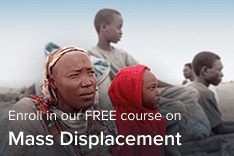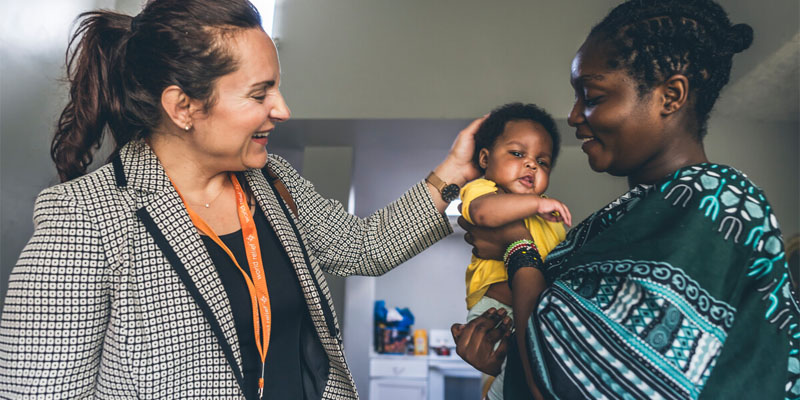“If you spend yourselves on behalf of the hungry and satisfy the needs of the oppressed, then your light will rise in the darkness, and your night will become like the noonday … You will be called Repairer of Broken Walls, Restorer of Streets with Dwellings.” — Isaiah 58:10,12
Around the world, families and communities are facing compounding crises — from displacement and hunger to economic instability and fractured relationships. In the face of these urgent challenges, local churches are uniquely positioned to build resilience and bring lasting change. They are often the first to respond when crisis strikes and the ones who remain, walking with people and rebuilding communities long after headlines fade and humanitarian responders go home.
At World Relief, we pursue the promise of Isaiah 58 by engaging the world’s greatest crises in partnership with the church. Yet, many churches struggle to know how to respond effectively. While some lack resources or support, others need a fresh vision of what it means to serve their communities holistically.
That’s where our Church Empowerment Zone (CEZ) model comes in. Through CEZs, churches are equipped to become collaborative leaders, effective responders and long-term changemakers. Rather than offering one-time interventions, CEZs build sustainable, Christ-centered development that fosters long-term resilience — rooted in church unity, local leadership and transformation.In 2024, we celebrated the graduation of 586 CEZ churches across Malawi, Kenya, Rwanda and Burundi! Graduation is an essential part of the CEZ model’s sustainability and long-term impact, marking the moment when, after about 5 years of training and engagement, World Relief steps back and local churches take full ownership of ongoing development projects and ministries in their communities.
A Model for Holistic Transformation
All over the world, churches often face similar challenges: limited resources, denominational divides and uncertainty about how to engage the deeper needs of their communities. CEZs are designed to meet churches in that place of uncertainty and equip them to respond with confidence, unity and purpose.
Each CEZ is made up of multiple Church Network Committees (CNCs). CNCs consist of 20 to 30 churches that journey together through a multi-year process of spiritual, relational and practical transformation. With support from World Relief staff, pastors and lay leaders receive training in important resilience-building areas like biblical justice, savings, conflict resolution, family strengthening and child protection.
In many cases, CEZs are supported by churches thousands of miles away — congregations in the United States who give generously, pray faithfully and stand in unity with their global sisters and brothers. This model is a beautiful picture of the church at its best: global in reach, local in impact and united in purpose.
In Rwanda’s Nyamasheke district, we’ve recently witnessed a powerful example of the transformation that can result. Many churches in the district were operating in isolation, focusing primarily on spiritual matters and serving only their own members. But through the CEZ model, they began working across denominations, launching outreach ministries and becoming trusted leaders in their communities.
Today, the recently graduated Nyamasheke CEZ is investing in their community’s resilience and spending themselves on behalf of those in need. As a result, they’re reaping the fruit of spiritual, economic and relational transformation.
Here are just a few of the achievements we are celebrating with them:
- 635 savings groups were launched, saving a total of $668,395
- 1,980 jobs were created through member-led initiatives
- 3,135 people came to faith through church-led outreach
- Churches with active community ministries increased from 5.7% to 90.6%
- 85% of churches integrated community development into their ministry plans
- 89% of churches began mobilizing local volunteers and partners
- Women’s participation in household decision-making rose from 68% to 86%
These outcomes offer just a glimpse of what’s possible when churches are equipped through the CEZ model. While each zone operates within its own context, Nyamasheke CEZ shows the depth and scale of transformation that can take place when local churches unite around a shared vision for holistic mission.
Eugene and Vestine: Women’s Economic Empowerment in Action
While we praise God for these remarkable data points, we’re even more excited by the impact they mean in the lives of individuals like Eugenie and Vestine. Both pastors’ wives, they never imagined themselves leading a business or employing others. Like many women in their community, they believed their duties at home barred them from earning income for their families.
That mindset began to shift when their churches joined a CEZ and participated in church-led training on savings, entrepreneurship and biblical identity. Through the CEZ, they joined a women’s savings group, took out a small loan and began a tea farming business.
“In the past, we depended solely on our husbands’ resources,” Eugenie shared. “We thought a pastor’s wife should stay home, but the training showed us we had potential.”
The business quickly grew. Within a year, they had repaid their loan, expanded their operations and created jobs for 10 people. With the income they have earned so far, Eugenie and Vestine have renovated their homes, purchased vehicles for their husbands and ensured their children can attend school. They are committed to expanding their investments in the future and have become models of leadership in their churches and communities.
Their story reflects a key principle of CEZs: that transformation begins when churches recognize and invest in the God-given gifts of their people — especially those who are often overlooked.
Bosco and Nyiranzabandora: Healing Families and Restoring Relationships
Church Empowerment Zones aren’t just sparking economic opportunities, however. As churches deepen their understanding of their mission, they are nurturing holistic flourishing by addressing broken relationships, strengthening families and fostering spiritual renewal. And that’s creating radical relational transformation in the lives of people like Bosco and his wife Nyiranzabandora.
Conflict and distrust had broken their marriage, and Bosco had started a second family with another woman. The couple was separated for nine years.
Their journey toward reconciliation began when their church was equipped through their CEZ to introduce the Families for Life program. Facilitated by trained volunteers, Families for Life equips couples with biblical tools for communication, forgiveness, conflict resolution and joint decision-making.
At first, Bosco and Nyiranzabandora attended sessions together but returned to their separate homes. But as they progressed, their hearts began to soften. “We began to reflect deeply on what we were learning,” Nyiranzabandora said. “This led us to a powerful decision — we agreed to reconcile and sought forgiveness from each other.”
Bosco returned home. Nyiranzabandora welcomed his three children from the second relationship into their family. After 14 years together and nearly a decade apart, they have legalized their marriage, are now active members of their church and are creating a healthier home life for their 10 children.
This restoration was made possible because the church decided to walk with them even in the most painful places, restoring what was broken and offering hope and healing for their household and beyond.
Sustaining Transformation Beyond Graduation
The restoration experienced by Eugenie and Vestine, Bosco and Nyiranzabandora are what CEZs are designed to cultivate — and it doesn’t end when churches graduate from the program. In fact, that’s just the beginning.
CEZs are built on the belief that local churches are not only capable of leading transformation in their communities, but called to do so. As churches grow in unity, capacity and vision, World Relief intentionally steps back so that local churches can lead. Because when churches are equipped and empowered, they don’t just maintain the work — they multiply it.
We call the final phase of the CEZ model “Continuing as Friends.” Churches continue to meet regularly, launch new ministries and even share their learnings with neighboring congregations. World Relief staff are available to provide support as needed for two or so years, as churches become more and more independent.What begins as facilitated training becomes a self-sustaining movement of locally-led transformation. As one Rwandan pastor, Karimunda John, shared, “The light started to come after discovering that we need each other as church leaders, and that we have the same calling, which is to preach the Good News and support the most vulnerable as Jesus did … we will not cease to sustain the program activities that we have been implementing in partnership with World Relief.”
The Church, Equipped for Today’s Crises
The challenges our world faces are growing in scale and complexity. As conflict, hunger, poverty and climate crises deepen across the world, the need for churches to rise up and respond has never been greater.
Through CEZs, we see what’s possible when local churches are equipped to live out the gospel in both word and deed, bringing healing, transformation and resilience that endure long after World Relief departs.
Over the last 15 years, thanks to the generosity of churches and donors like you, we have partnered with more than 4,000 churches in eight countries through CEZs, building resilient communities that can sustainably withstand crisis, recover with dignity and flourish for generations to come.
And with so much at stake, we’re not stopping there. We are actively working to adapt our church partnership models and expand our work with churches to reach even more communities facing today’s greatest crises — empowering churches to respond with compassion, collaboration and lasting impact.
Thank you for standing with us and with churches around the world in this work.


